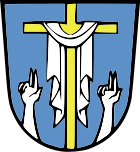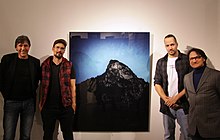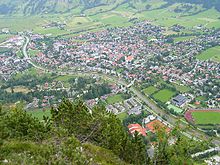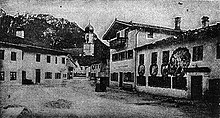Oberammergau
| coat of arms | Germany map | |
|---|---|---|

|
Coordinates: 47 ° 36 ' N , 11 ° 4' E |
|
| Basic data | ||
| State : | Bavaria | |
| Administrative region : | Upper Bavaria | |
| County : | Garmisch-Partenkirchen | |
| Height : | 837 m above sea level NHN | |
| Area : | 30.06 km 2 | |
| Residents: | 5514 (Dec. 31, 2019) | |
| Population density : | 183 inhabitants per km 2 | |
| Postal code : | 82487 | |
| Area code : | 08822 | |
| License plate : | Cap | |
| Community key : | 09 1 80 125 | |
| Community structure: | 2 parts of the community | |
| Address of the municipal administration: |
Ludwig-Thoma-Strasse 10 82487 Oberammergau |
|
| Website : | ||
| Mayor : | Andreas Rödl ( CSU ) | |
| Location of the municipality of Oberammergau in the Garmisch-Partenkirchen district | ||
Oberammergau is a municipality in the Upper Bavarian district of Garmisch-Partenkirchen and is located in the Ammergau Alps Nature Park . It is located in the Ammer Valley on the Ammer River . Oberammergau is best known for its ten-year Passion Play , which was last performed in 2010, as well as the local artisans with carvers and the houses decorated with Lüftlmalerei . Worth seeing examples of this baroque painting include the facades of the forester's house, the Mußldomahaus and the Pilatushaus.
geography
geology
The glaciers of the Ice Ages carved the valleys, leaving moraines on the edges and tongues of the glacier . In the interglacial periods, the glaciers melted and the meltwater of the retreating Ammer glacier created lakes. The flowing water masses built stone rubble mountains , which sometimes piled up into obstacles and forced the water to detour. Places like Ettal , Oberammergau and Unterammergau emerged on the rubble .
The striking local mountain Kofel ( 1342 m ) is only about a kilometer away from the town center .
The municipality has two officially named parts of the municipality (the type of settlement is indicated in brackets ):
- Oberammergau ( parish village )
- Saint Gregor ( village )
climate
With 1,471 millimeters of annual precipitation , Oberammergau is one of the wettest places in Germany.
The driest month is February; it rains most in July. In the wettest month there is about 2.6 times as much rain as in the driest month. The seasonal fluctuations in precipitation are in the upper third. In over 99% of all locations, the monthly precipitation fluctuates less.
Oberammergau is located in the Ammergau Alps Nature Park .
history
According to the chronicle of Pastor Joseph Alois Daisenberger, who was active in pastoral care in Oberammergau from 1854 to 1883, little is known of the Celtic settlement there. This also applies to Roman times. The area was Christianized by the monk Thosso. He was the companion of St. Magnus von Füssen .
At the end of the 9th century, the Welfe Ethiko settled in Ammergau. He founded a monastery there, which was moved to Swabia under his successors. The income from the existing goods was used by a priest in the Ammertal. 1074 donated Welf IV. The monastery Rottenbuch . From then on, this was ordered by the pastors in Ammergau. Around 1120 there was a church in Oberammergau founded by the Welfs. After the death of his only son in 1167, Welf VII donated some goods to the Kempten monastery in the Ammertal in his memory . He sold the other properties to Emperor Friedrich Barbarossa , the Staufer . After the death of Konradin , all possessions of the Hohenstaufen family went to Duke Ludwig von Wittelsbach in 1269 . They remained in the possession of this Bavarian ducal house until 1918.
It was of particular importance to Oberammergau when Ludwig the Bavarian vowed on a campaign to found a monastery for salvation from dire need. During the construction of 1330 in Ettal, the farmers received inheritance and building rights for their help. In return, the knights ensured security. With the construction of the monastery, the renewal of the path from Au ( Oberau ) via the Kienberg to Ammergau went hand in hand. The local Oberammergau wagoners, called the Rottmanns, were responsible for a certain section of the Rottstrasse. Everyone had to maintain their part and, as a knowledgeable local, ensure safe transport on their section. As another privilege Kaiser confessed Ludwig of Bavaria the upper Ammer Gauern 1332 the settlement rights to. This meant that there the goods had to be reloaded onto the Rott people's vehicles and offered on site. This formed the basis for the development of brisk trade between Italy and Germany. From 1530 the wagoners were allowed to demand a cruiser road allowance for a loaded rotting wagon . Towards the end of the 16th century the rotting industry declined as the merchants looked for other ways. Only carving experienced a further boom and the Ettal Abbey therefore issued a craft regulations.
Around 1600 there were two bodies in Oberammergau. The local council or "Council of the Six" directed the fortunes of the place with the support of "the twelve". These people were each elected for a year and were under the judge of Ettal. His superior was the nurse from Murnau. There the negotiations of important "criminal matters" took place. The Daisenberger Chronicle reports that the local residents were doing well and that many became prosperous. During the Thirty Years' War (1618–1648) the local residents suffered a few times from the passage of imperial troops and (only) once from an attack by Swedish troops.
At the beginning of the 17th century, the increasing population caused the Ettal abbot Leonhard Hilpolt and the Murnau nurse Urban Morhard to arrange for voluntary or forced emigration of illegally newcomers.

The Hofmark Oberammergau was part of the dominion Court Murnau Ettal Monastery and until 1803 seat of the Upper and Lower Court. In 1818 (after the Congress of Vienna ), as part of the administrative reforms in the Kingdom of Bavaria, today's municipality, which belonged to the Schongau Regional Court .
In 1938 the municipality became the location of the Wehrmacht . Above all, mountain , intelligence and medical units were housed there.
During the Second World War , from October 1943, a large testing and manufacturing facility for fighter aircraft from Messerschmitt AG (" Upper Bavarian Research Institute ") was operated in the former Hötzendorf mountain hunter barracks . Forced laborers had to work under the supervision of SS units of Hans Kammler , who was also "Special Representative of the Reichsführer SS for the A4 program ", for the underground relocation of the German armaments industry and, as part of the Alpine fortress , an underground factory in the mountain under the cover name "Cerusit" Laber build. For this purpose, tunnels and caverns were carved out of the rock. In mid-April 1945 the SS evacuated approx. 450 employees of the A4 program of the Peenemünde Army Research Center from Bad Sachsa and placed them under strict guard in Oberammergau, including Walter Dornberger and Wernher von Braun . On the morning of April 29, 1945, Oberammergau was occupied by US troops after a brief period of fierce resistance from the mountain troops.
Population development
Between 1988 and 2018 the community grew from 4,980 to 5,474 by 494 inhabitants or 9.9%.
politics
Municipal council
The municipal council of Oberammergau consists of 20 members, plus the first mayor. The local elections on March 15, 2020 led to the following result:
| Party / list | Share of votes | Seats | +/- |
|---|---|---|---|
| CSU | 23.99% | 5 | + 2 |
| Non-party voter community (PWG) | 26.51% | 5 | ± 0 |
| With a sense of proportion | 21.14% | 4th | - 1 |
| Citizens' Initiative Oberammergau (BIO) | 15.87% | 3 | ± 0 |
| Colorful in Oberammergau (Colorful List) | 12.48% | 3 | + 3 |
| Committed citizens | - | - | - 2nd |
| The list of women | - | - | - 2nd |
| total | 100% | 20th | |
| Turnout: 65.51% | |||
mayor
The first mayor of the community is Andreas Rödl (CSU). In the mayoral election in 2020 he was elected with 54.80% of the valid votes. He succeeds Arno Nunn, who was no longer a candidate. Rödl's competitor Ludwig Utschneider (non-party voter community) received 45.20% of the vote.
coat of arms
Blazon
The coat of arms description reads:
- "In blue, a golden Passion Cross continuous above and below with a hanging silver cloth, on both sides a growing silver hand of oath."
Coat of arms history
The blue field marking points to the sky and, together with the silver, is reminiscent of the Bavarian national colors. The cross with the cloth stands for the world-famous Passion Play. Its origin found its way into the hands raised on both sides in an oath. These symbolize the year 1633 with the vow of the residents to perform, experience and pass on the Passion of Christ every ten years.
Town twinning
Culture and sights
Lüftlmalerei
The townscape of Oberammergau is particularly characterized by the Lüftlmalerei . In Upper Bavaria this is the art of painting facades in color. It brought recognition to the Oberammergau family Zwinck at home and beyond the borders of the town. The expression probably goes back to the colloquial term “at the Lüftl”. This is how the home of the famous Oberammergau facade painter Franz Seraph Zwinck was called.
On the painted facades of the houses, scenes from the Passion of Christ were often depicted among the numerous Christian motifs.
In addition to the Christian motifs, many scenes of the Lüftlmalerei on the house facades tell of people's everyday life.
Birthplace of Ludwig Thoma
Theaters and museums
Buildings
Parish Church of St. Peter and Paul
The Catholic parish church of Oberammergau is an important example of the southern German baroque.
Crucifixion group
When visiting the Oberammergau Passion Play on September 25, 1871, King Ludwig II was so impressed that he donated this group. On October 15, 1875, after a two-year design period, the sculptor Johann von Halbig consecrated the monument to Archbishop von Scherr. It cost 400,000 guilders .
The then largest stone monument in the world is twelve meters high, weighs 1,120 hundredweight and is made of Kelheim marble.
The king held silent devotions in this place on the consecration day for several years until the public interest made this impossible.
Contemporary Arts

In 2015 the two artists Sebastian Hertrich and Sebastian Wanke installed a light installation on the summit of Oberammergau's local mountain, the Kofel . The results were presented in 2016 in the exhibition "Made in Oberammergau" in the pavilion of the State College for Wood Sculpture in Oberammergau.
Regular events
Passion play
In the year of the plague in 1633, the inhabitants of Oberammergau vowed to regularly perform a passion play . Today the Oberammergau Passion Play takes place every ten years with the broad participation of the local population. In 2000, around 500,000 visitors from all over the world attended what is probably the world's most famous passion play in the Oberammergau Passion Play Theater. In 2010, the residents of the municipality of Oberammergau performed the game for the 41st time, with a total of more than 515,000 viewers attending the 109 performances. The next Passion Play will take place in 2022.
Others
- The traditional König-Ludwig-Langlauf takes place every year, in which several thousand participants start in the free (Saturday) and the classic technique (Sunday). The König-Ludwig-Lauf is the largest ski marathon in Germany (1st February weekend).
- The traditional King Ludwig Fire takes place on August 24th every year .
- Tattoo by the Oberammergau band (evening before Corpus Christi)
- Corpus Christi procession
- Annual concert of the Musikverein (every year on April 30th)
- Kathrein dance (November)
- Operas and plays in the Passion Play Theater
Soil monuments
See: List of soil monuments in Oberammergau
Economy and Infrastructure
Wood carving
The art of wood carving goes back to the Middle Ages. In 1111 there are reports of Rottenbuch monks who carved things for household items. The carving of religious motifs was likely influenced by the nearby Ettal Abbey.
In the 16th century, the sources report for the first time about several inhabitants of Oberammergau who trade in the products of their carving art. By the abbot of Ettal Abbey, the carving craftsmen were given their own craft regulations in 1563 . The goods were always sold locally. In the following century several names of Oberammergau citizens appear in connection with their carving art: "These are above all the Kriegls, the Ruetz, the Auers, the Glöggls, the families Ederle, Rainer, Ray and Zwink."
The trade in carving products reached a high point when numerous branches were established in Germany and across Europe in the 18th century. B. in St. Petersburg , Copenhagen , Trondheim , Gothenburg , Cádiz , Bremen , Groningen and Amsterdam . From there the goods were brought to the man by peddling the carrier .
In order to secure the next generation for this lucrative trade, Ludwig Lang began to teach local children in it. In 1890 the carving school found new quarters on Ettaler Strasse. From 1908 it was possible to take a journeyman's examination here. In 1909, 100 students moved into the newly built building of the carving school. It was designed by the Munich architect Franz Zell . In 2013, the school was expanded by the Munich architects abp architects burian + pfeiffer to include an exhibition room made of wood. At today's wood carving school in Oberammergau, a state vocational school for wood sculptors , a journeyman's certificate can be acquired after a three-year training course.
traffic
Oberammergau is on the national highway 23 ( German Alpine Road ) and on the hourly circulating ammergau railway , which in Murnau from the Munich-Garmisch-Partenkirchen railway to reach branches and has its end point in oberammergau. A road begins between Oberammergau and Ettal (in Germany: Bayerische Staatsstrasse 2060; in Austria: Tiroler Landesstrasse 255), which leads past Linderhof Castle over the Ammersattel to Tyrolean Plansee and to Reutte .
The small cable car Laber-Bergbahn leads from the village to the Laber. The Kolbensesselbahn, a double chairlift, leads from the valley station on the western edge of the village to the mountain station at the Kolbensattel (1270 m above sea level), where the Kolbensattelhütte is located.
Education and Research
- Oberammergau is the location of the Bundeswehr Education Center - Oberammergau teaching area (formerly Bundeswehr Administration School IV). There, administrative officials of the middle service and administrative clerks are trained. In addition, numerous advanced and advanced training measures are carried out for the employees of the Bundeswehr administration.
- On the site of the 1935 built Conrad von Hötzendorf - barracks in the district of St. Gregory at the foot of Laber mountain is the NATO School as the primary training and education center of NATO on the operational level. Various courses on topics of politics and strategy are offered there for NATO members and various NATO partners. Every year more than 10,000 course participants from 60 countries attend the NATO school.
tourism
The municipality of Oberammergau is part of the Ammergau Alps tourist region. The region is represented in terms of tourism by the Ammergauer Alpen GmbH. In addition to Oberammergau, the Ammergau Alps nature park region includes the villages of Unterammergau , Bad Bayersoien , Bad Kohlgrub , Ettal / Graswang / Linderhof and Saulgrub / Altenau / Wurmansau.
In 2018 Oberammergau generated approx. 364,000 overnight stays and almost 93,000 arrivals.
Sons and daughters of the church
- Auguste Meyer (1861–1929), opera singer and singing teacher
- Ludwig Thoma (1867–1921), writer
- Martha Krause-Lang (1912–2016), pioneer of social work in Germany and university professor
- Ernst Maria Lang (1916–2014), architect in Munich and caricaturist for the Süddeutsche Zeitung from 1947 to 2003
- Max Streibl (1932–1998), politician (CSU), Bavarian Minister-President from 1988 to 1993
- Nikolaus Lang (* 1941), artist, professor at the Academy of Arts in Munich from 2000 to 2005
- Elisabeth Endres (1942–2011), painter
- Michaela Geiger (1943–1998), politician (CSU), Member of the Bundestag and Vice President of the German Bundestag
- Gregor Betz (* 1948), swimmer and Olympic participant
- Tomas Erhart (* 1959), cameraman, director and film producer
- Christian Stückl (* 1961), director and general manager of the Münchner Volkstheater, director of the Passion Play in 1990, 2000 and 2010
- Ursula Maria Burkhart (* 1961), actress, since 2002 in the ensemble of the Münchner Volkstheater
- Rita Falk (* 1964), author
- Isolde Holderied (* 1966), rally driver
literature
- Eugen Roth , Claus Hansmann (photos): Oberammergau. Bruckmann Verlag , Munich 1960. English edition translated by Elizabeth Thompson, Munich 1960.
- Ludwig Utschneider: Oberammergau in the Third Reich - 1933–1945. Historical Association Oberammergau 1999 e. V., Oberammergau 2012 (revised and expanded new edition), ISBN 978-3-9807212-5-7 .
- Ludwig Utschneider: The street names of Oberammergau . Historical Association Oberammergau 1999 e. V., Oberammergau 2005.
- Ludwig Utschneider: Bibliography on the history of Oberammergau and the Passion Play . (= Der Ammergau, series of publications by the Historisches Verein Oberammergau; Volume 3). Historical Association Oberammergau 1999 e. V., Oberammergau 2003, ISBN 3-9807212-2-1 ( full text as PDF ( memento of June 10, 2007 in the Internet Archive ))
- Gerd Holzheimer, Elisabeth Tworek, Herbert Woyke (eds.): Suffering creates passions. Oberammergau and its game. A1 Verlag , Munich 2000, ISBN 3-927743-49-6 .
- Christine Rädlinger : Oberammergau 1869–2000 - Between tradition and progress. Self-published by the municipality of Oberammergau 2002, ISBN 3-930000-08-3 .
Web links
- Oberammergau im Panoport travel guide
- Local government site
- Entry on the coat of arms of Oberammergau in the database of the House of Bavarian History
- Historical Association Oberammergau 1999
- Oberammergau: Official statistics of the LfStat
- Oberammergau (tourism portal of the Ammergau Alps)
Individual evidence
- ↑ "Data 2" sheet, Statistical Report A1200C 202041 Population of the municipalities, districts and administrative districts 1st quarter 2020 (population based on the 2011 census) ( help ).
- ↑ a b Heinfried Barton: The Ammergau Alps . 2nd Edition. Frankh'sche Verlagshandlung W. Keller & Co., Stuttgart 1989, ISBN 3-440-04817-9 .
- ^ Municipality of Oberammergau in the local database of the Bavarian State Library Online . Bayerische Staatsbibliothek, accessed on September 5, 2019.
- ↑ a b c d e f g h i Joseph Alois Daisenberger: The history of the village. Klaus Höldrich, accessed January 6, 2013 .
- ↑ a b c d e f g h i j k l m n o p local history. Historischer Verein Oberammergau, accessed on January 6, 2013 .
- ^ Alois Schwarzmüller: An End of War - Garmisch-Partenkirchen on April 29, 1945. Retrieved on October 4, 2019 .
- ↑ Election of the first mayor in 2020, municipality of Oberammergau
- ↑ a b c d e Information board on the crucifixion group
- ↑ a b c Carving and handicrafts. Ammergauer Alpen GmbH, accessed on December 20, 2012 .
- ↑ Folklore of the future. in Frankfurter Allgemeine Zeitung of September 25, 2013, p. 28.
- ↑ Welcome to the Oberammergau carving school. Carving School Oberammergau, accessed on December 26, 2012 .
- ↑ Laber-Bergbahn , www.ammergauer-alpen.de
- ↑ Kolbensesselbahn , kolbensattel.de
- ^ Website of the Ammergau Alps tourist region



























